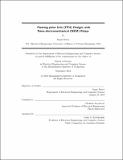Floating-point unit (FPU) designs with nano-electromechanical (NEM) relays
Author(s)
Dutta, Sumit, Ph. D. Massachusetts Institute of Technology
DownloadFull printable version (8.983Mb)
Alternative title
Floating-point unit designs with nano-electromechanical relays
FPU designs with NEM relays
Other Contributors
Massachusetts Institute of Technology. Department of Electrical Engineering and Computer Science.
Advisor
Vladimir Stojanović.
Terms of use
Metadata
Show full item recordAbstract
Nano-electromechanical (NEM) relays are an alternative to CMOS transistors as the fabric of digital circuits. Circuits with NEM relays offer energy-efficiency benefits over CMOS since they have zero leakage power and are strategically designed to maintain throughput that is competitive with CMOS despite their slow actuation times. The floating-point unit (FPU) is the most complex arithmetic unit in a computational system. This thesis investigates if the energy-efficiency promise of NEM relays demonstrated before on smaller circuit blocks holds for complex computational structures such as the FPU. The energy, performance, and area trade-offs of FPU designs with NEM relays are examined and compared with that of state-of-the-art CMOS designs in an equivalent scaled process. Circuits that are critical path bottlenecks, including primarily the leading zero detector (LZD) and leading zero anticipator (LZA) blocks, are carefully identified and optimized for low latency and device count. We manage to drop the NEM relay FPU latency from 71 mechanical delays in a CMOS-style implementation to 16 mechanical delays in a NEM relay pass-logic style implementation. The FPU designed with NEM relays features 15x lower energy per operation compared to CMOS.
Description
Thesis (S.M.)--Massachusetts Institute of Technology, Dept. of Electrical Engineering and Computer Science, 2013. This electronic version was submitted by the student author. The certified thesis is available in the Institute Archives and Special Collections. Includes bibliographical references (pages 71-74).
Date issued
2013Department
Massachusetts Institute of Technology. Department of Electrical Engineering and Computer SciencePublisher
Massachusetts Institute of Technology
Keywords
Electrical Engineering and Computer Science.